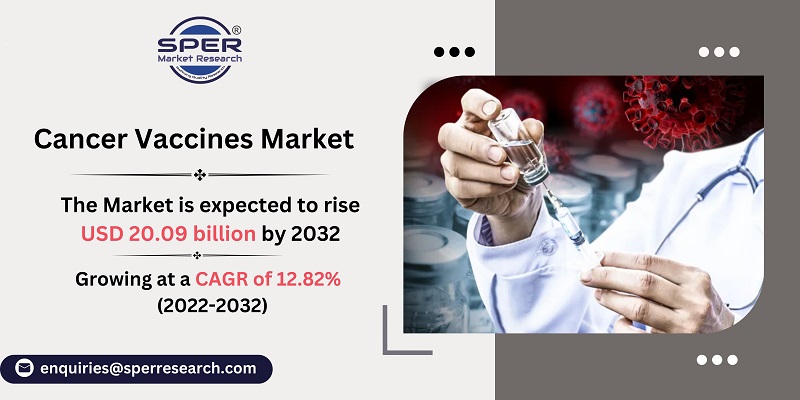
Cancer Vaccines Market Growth, Size, Trends, Demand, Revenue, Competition and Future Outlook
Global Cancer Vaccines Market Size- By Technology, By Type, By Indication, By End User - Regional Outlook, Competitive Strategies and Segment Forecast to 2032
| Published: Dec-2022 | Report ID: HLCA2233 | Pages: 1 - 242 | Formats*: |
| Category : Healthcare | |||

| Report Metric | Details |
| Market size available for years | 2019-2032 |
| Base year considered | 2021 |
| Forecast period | 2022-2032 |
| Segments covered | By Technology, By Type, By Indication, By End User |
| Regions covered | North America, Europe, Asia Pacific, Latin America, Middle East and Africa |
| Companies Covered | Aduro Biotech, Advantagene, Advaxis, Agenus, Altor BioScience, Argos Therapeutics, Dendreon, GlaxoSmithKline, Onco Thyreon, Oncovir, Oxford BioMedical, Prsima BioMed, Sotio, Transgene, Ubivac, Vaccinogen, Vaxon Biotech. |
- Biopharmaceutical Companies
- Clinical Researchers and Oncologists
- Regulatory Authorities
- Healthcare Providers
- Patients and Caregivers
- Investors and Funding Organizations
- Academic and Research Institutions
- Pharmaceutical Distributors and Suppliers
- Cancer Advocacy Groups
| By Type: |
|
| By Indication: |
|
| By End User: |
|
- Global Cancer Vaccines Market Size (FY’2023-FY’2033)
- Overview of Global Cancer Vaccines Market
- Segmentation of Global Cancer Vaccines Market By Technology (Dendritic Cells (DC) Cancer Vaccines, Recombinant Cancer Vaccines, Antigen/Adjuvant Cancer Vaccines, Viral Vector & DNA Cancer Vaccines.)
- Segmentation of Global Cancer Vaccines Market By Type (Preventive Cancer Vaccines, Therapeutic Cancer Vaccines.)
- Segmentation of Global Cancer Vaccines Market By Indication (Cervical Cancer, Prostate Cancer Others.)
- Segmentation of Global Cancer Vaccines Market By End User (Pediatrics, Adults.)
- Statistical Snap of Global Cancer Vaccines Market
- Expansion Analysis of Global Cancer Vaccines Market
- Problems and Obstacles in Global Cancer Vaccines Market
- Competitive Landscape in the Global Cancer Vaccines Market
- Impact of COVID-19 and Demonetization on Global Cancer Vaccines Market
- Details on Current Investment in Global Cancer Vaccines Market
- Competitive Analysis of Global Cancer Vaccines Market
- Prominent Players in the Global Cancer Vaccines Market
- SWOT Analysis of Global Cancer Vaccines Market
- Global Cancer Vaccines Market Future Outlook and Projections (FY’2023-FY’2033)
- Recommendations from Analyst
1.1. Scope of the report1.2. Market segment analysis
2.1 Research data source
2.1.1 Secondary data2.1.2 Primary data2.1.3 SPER’s internal database2.1.4 Premium insight from KOL’s
2.2 Market size estimation
2.2.1 Top-down and Bottom-up approach
2.3 Data triangulation
4.1. Driver, Restraint, Opportunity and Challenges analysis
4.1.1 Drivers4.1.2 Restraints4.1.3 Opportunities4.1.4 Challenges
4.2. COVID-19 Impacts of the Global Cancer Vaccines Market
5.1. SWOT analysis
5.1.1 Strengths5.1.2 Weaknesses5.1.3 Opportunities5.1.4 Threats
5.2. PESTEL analysis
5.2.1 Political landscape5.2.2 Economic landscape5.2.3 Social landscape5.2.4 Technological landscape5.2.5 Environmental landscape5.2.6 Legal landscape
5.3. PORTER’S five forces analysis
5.3.1 Bargaining power of suppliers5.3.2 Bargaining power of Buyers5.3.3 Threat of Substitute5.3.4 Threat of new entrant5.3.5 Competitive rivalry
5.4.Heat map analysis
6.1. Antigen/Adjuvant Cancer Vaccines6.2. Dendritic Cells (DC) Cancer Vaccines6.3. Recombinant Cancer Vaccines6.4. Viral Vector & DNA Cancer Vaccines
7.1. Preventive Cancer Vaccines7.2. Therapeutic Cancer Vaccines
8.1. Cervical Cancer8.2. Prostate Cancer8.3. Others.
9.1. Pediatrics9.2. Adults
10.1. North America
10.1.1. Canada10.1.2. Mexico10.1.3. United States
10.2. Europe
10.2.1. France10.2.2. Germany10.2.3. Italy10.2.4. Rest of Europe10.2.5. Spain10.2.6. United Kingdom
10.3. Asia-Pacific
10.3.1. Australia10.3.2. China10.3.3. India10.3.4. Japan10.3.5. Rest of Asia-Pacific10.3.6. South Korea
10.4. South America
10.4.1. Brazil10.4.2. Argentina10.4.3. Rest of South America
10.5. Middle East & Africa
10.5.1. Kingdom of Saudi Arabia10.5.2. United Arab Emirates10.5.3. Rest of Middle East & Africa
11.1.1. Company details11.1.2. Financial outlook11.1.3. Product summary11.1.4. Recent developments
11.2.1. Company details11.2.2. Financial outlook11.2.3. Product summary11.2.4. Recent developments
11.3.1. Company details11.3.2. Financial outlook11.3.3. Product summary11.3.4. Recent developments
11.4.1. Company details11.4.2. Financial outlook11.4.3. Product summary11.4.4. Recent developments
11.5.1. Company details11.5.2. Financial outlook11.5.3. Product summary11.5.4. Recent developments
11.6.1. Company details11.6.2. Financial outlook11.6.3. Product summary11.6.4. Recent developments
11.7.1. Company details11.7.2. Financial outlook11.7.3. Product summary
11.7.4. Recent developments
11.8.1. Company details11.8.2. Financial outlook11.8.3. Product summary11.8.4. Recent developments
11.9.1. Company details11.9.2. Financial outlook11.9.3. Product summary11.9.4. Recent developments
11.10.1. Company details11.10.2. Financial outlook11.10.3. Product summary11.10.4. Recent developments
11.11.1. Company details11.11.2. Financial outlook11.11.3. Product summary11.11.4. Recent developments
11.12.1. Company details11.12.2. Financial outlook11.12.3. Product summary11.12.4. Recent developments
11.13.1. Company details11.13.2. Financial outlook11.13.3. Product summary11.13.4. Recent developments
11.14.1. Company details11.14.2. Financial outlook11.14.3. Product summary11.14.4. Recent developments
11.15.1. Company details11.15.2. Financial outlook11.15.3. Product summary11.15.4. Recent developments
11.16.1. Company details11.16.2. Financial outlook11.16.3. Product summary11.16.4. Recent developments
11.17.1. Company details11.17.2. Financial outlook11.17.3. Product summary11.17.4. Recent developments
SPER Market Research’s methodology uses great emphasis on primary research to ensure that the market intelligence insights are up to date, reliable and accurate. Primary interviews are done with players involved in each phase of a supply chain to analyze the market forecasting. The secondary research method is used to help you fully understand how the future markets and the spending patterns look likes.
The report is based on in-depth qualitative and quantitative analysis of the Product Market. The quantitative analysis involves the application of various projection and sampling techniques. The qualitative analysis involves primary interviews, surveys, and vendor briefings. The data gathered as a result of these processes are validated through experts opinion. Our research methodology entails an ideal mixture of primary and secondary initiatives.



Frequently Asked Questions About This Report
PLACE AN ORDER
Year End Discount
Sample Report
Pre-Purchase Inquiry
NEED CUSTOMIZATION?
Request CustomizationCALL OR EMAIL US
100% Secure Payment






Related Reports
Our Global Clients
Our data-driven insights have influenced the strategy of 200+ reputed companies across the globe.




















